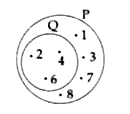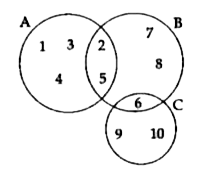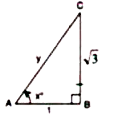From the adjoining Venn diagram , find the following sets :
Q
The correct Answer is:Q={b,f,d,g,h,j,l}
To solve the question regarding the Venn diagram and the set Q, we will follow these steps:
1. Identify the Universal Set:
- The universal set is typically represented by a rectangle in a Venn diagram. It contains all the elements under consideration.
2. Identify the Set Q:
- The set Q is represented by a specific circle within the rectangle. We need to look at the elements that fall within this circle to define set Q.
3. List the Elements of Set Q:
- Examine the Venn diagram to see which elements are included in the circle representing set Q. Write down all the elements that belong to this set.
4. Confirm the Elements:
- Ensure that the elements listed are indeed part of set Q and not part of any other sets that may be represented in the Venn diagram.
5. Final Representation:
- Write the final representation of set Q in set notation, usually denoted as Q = {elements}.
Example Representation:
If the Venn diagram shows that set Q contains the elements {a, b, c}, then we would write:
- Q = {a, b, c}
- The universal set is typically represented by a rectangle in a Venn diagram. It contains all the elements under consideration.
- The set Q is represented by a specific circle within the rectangle. We need to look at the elements that fall within this circle to define set Q.
- Examine the Venn diagram to see which elements are included in the circle representing set Q. Write down all the elements that belong to this set.
- Ensure that the elements listed are indeed part of set Q and not part of any other sets that may be represented in the Venn diagram.
- Write the final representation of set Q in set notation, usually denoted as Q = {elements}.
If the Venn diagram shows that set Q contains the elements {a, b, c}, then we would write:
- Q = {a, b, c}
Similar Questions
From the adjoining Venn diagram , find the following sets :
PView SolutionFrom the adjoining Venn diagram , find the following sets :
P∩Q
View SolutionFrom the adjoining Venn diagram , find the following sets :
P∪QView SolutionFrom the adjoining Venn , diagram , find the following sets :

(i) P (ii) Q (iii) P∪Q (iv) P∩QView SolutionFrom the adjoining Venn diagram , find the following sets :

(i) P
(ii) Q
(iii) P∪Q
(iv) P∩QView SolutionFrom the adjoining Venn diagram , find the following sets :

(i) A (ii) B (III) A∪B (iv) A∩BView SolutionFrom the adjoining Venn diagram , write the following sets : (i) A (ii) B (iii) C (iv) A∪B (v) A∩B (vi) B∪C (vii B∩C (viii) A∪C (ix)A∩C
Also verify that :
(i) n(A)+n(B)=(A∪B)+n(A∩B)
(ii) n(B)+n(C)=n(B∪C)+n(B∩C)
 View Solution
View SolutionIn the adjoining Venn diagram , A∪B is
View SolutionFrom the adjoining figure, find :

x∘View SolutionFrom the adjoining figure, find :

x∘View Solution

